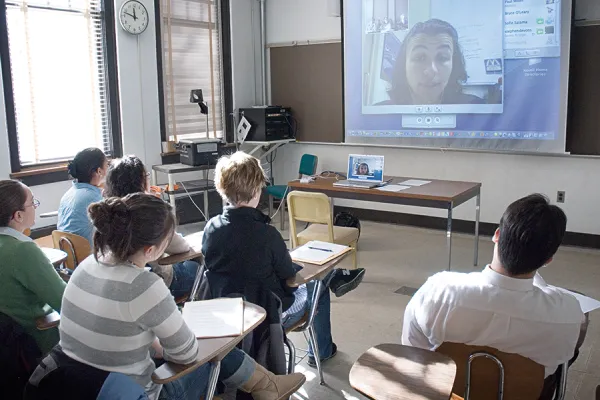Value of Classroom Visits by the Experts? Priceless
Research & Inquiry

Published March 28, 2011
Today’s agenda for Biology 323: a face-to-face conversation with Brigid Hogan, one of the world’s leaders in stem cell research and transgenic technology, a professor of cell biology at Duke University and director of the Duke Stem Cell Program.
It’s February 14, 2011, and students in this course, taught by Michael Barresi, assistant professor of biological sciences, have been studying the development of adult stem cells. Today’s is one of several visits they will host with world-renowned experts in the field of stem cell biology.
Normally, the cost for such visits would be prohibitive, possibly running to five figures, not to mention considerable outlay of time to arrange logistics. The cost for Hogan’s visit, and of other preeminent scientists throughout the semester: not a penny.
Through the use of Skype software, the interactions between Barresi’s students, in “Topics in Developmental Biology: Stem Cells and Their Amazing ‘Potential,’” and their guests take place via Internet conference.
Though the cost is low, the benefits of these sessions are too great to measure, says Barresi.
“This pedagogical approach is one of the best things I’ve done,” said Barresi, who has been coordinating Web conferences for two biology courses since 2005. “It really gets to the heart of learning. We’re going straight to the source who wrote the material we study in class.”
Barresi’s classes, including his course Biology 302, “Developmental Biology,” have hosted more than two dozen scientists, all leaders in their fields and specialties, Nobel Prize winners among them.
Getting to Know Them
“I’m kind of hoping with the Web conferences that my students will also begin to get an idea of what the scientific community is,” Barresi explained, “what they look like, how they talk, how they got where they are.”
Therefore, the Web conferences always begin by asking the visitors to talk about their backgrounds, their paths to becoming scientists.
“I don’t know quite when I fell in love with embryos but it was early on,” recalls Hogan, who is from northern England, to a class of 14 seated in a cavernous room deep inside the Media Services Center on Feb. 14.
The room is slightly darkened to enhance her image on screen. She is seated, in her office, it appears, with a standing lamp lighting her environs, framed degrees on the wall. Hogan’s face fills most the screen; for her, looking at her computer screen, a class of forward-facing students. “I spent a lot of time outside growing up, looking at nature, working with living things and how they develop.”
The students have prepared for the session by reading and analyzing notable writings by Hogan—or whomever the speaker happens to be—then preparing questions.
For Hogan, who focuses her research on the cellular structure of lungs, students ask, for example, about the development of adult stem cells; what the use of stem cells may mean for lung cancer therapies in the future; and whether it is worth harvesting human embryonic stem cells for research.
Straight From the Source
Barresi became interested in Web conferencing as a way to dig deeper to the source of the topics covered in class. Experts asked to visit Barresi’s class are chosen after he devises a reading list. Once he decides on pertinent readings, he contacts authors of some of the class materials to request a Web visit.
“I wanted to take our study of these topics to the next step,” he said. “Let’s go to the people who actually did the work.”
Useful as the Web conferences are to Barresi’s classes, much of their value carries over long after the class session is done. Following the conferences, Barresi posts the sessions on his Web site in their entirety, arranged with the questions followed by a clickable answer from the expert recorded during the conference. He often refers to past sessions with experts in subsequent courses.
While Barresi is the most enthusiastic user of Web conferencing among Smith faculty, others, mostly in the sciences and engineering, have used the method as well.
Susannah Howe, a senior lecturer in engineering and director of the Design Clinic, has found the tool useful for hosting guest speakers from afar.
“I’ve really appreciated being able to bring people from farther away and not imposing too much on their time,” she said. Howe is hosting a series of “Career Spotlights” via Skype this spring, in which guests briefly discuss their careers, followed by student questions. “Speakers are very willing to share their experiences and time with the students. So far, the experience has been a resounding success.”
Web conferencing is only one way Barresi uses technology to teach. He has also pioneered Lecture Capture on campus, a software package with which he records his lectures and posts them online so that students can “re-attend” class while working on their own. And he assigns his students in the stem cell course to make a documentary film on stem cells, which is posted on his Web site.
For Barresi, teaching methodology is about using all available avenues to getting the points across—in-class lectures, demonstrations, field trips, whatever it takes.
“I’m a very adventurous person, so I like to try new things,” he said. “But I use the chalkboard, too, the blackboard, the whiteboard…”
Students in Michael Barresi’s class, Developmental Biology, converse with Sofie Salama via Web conference.